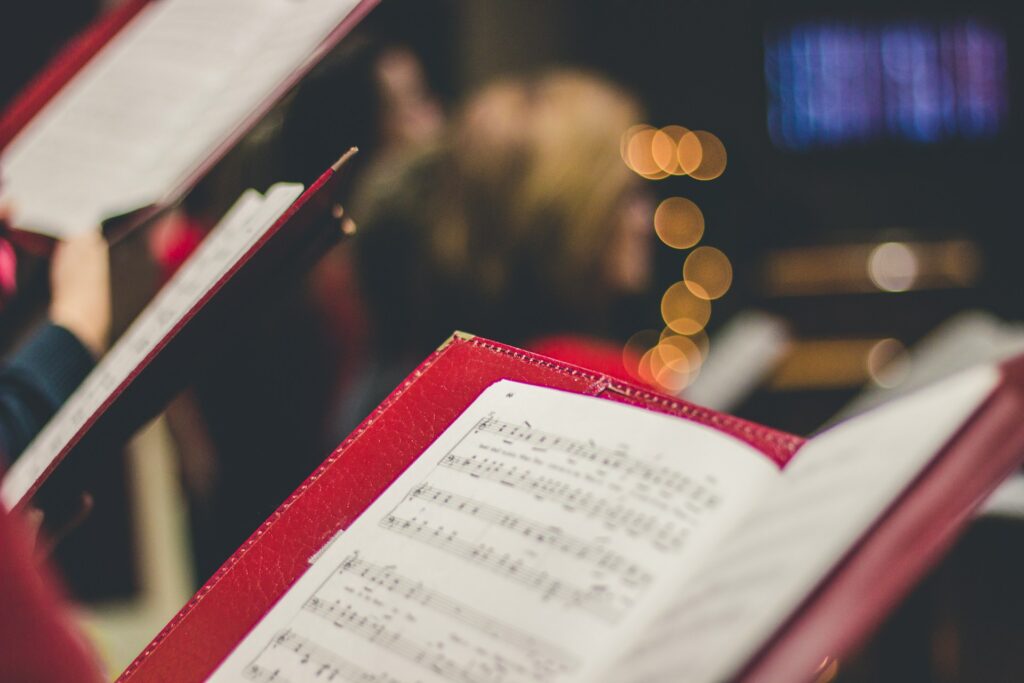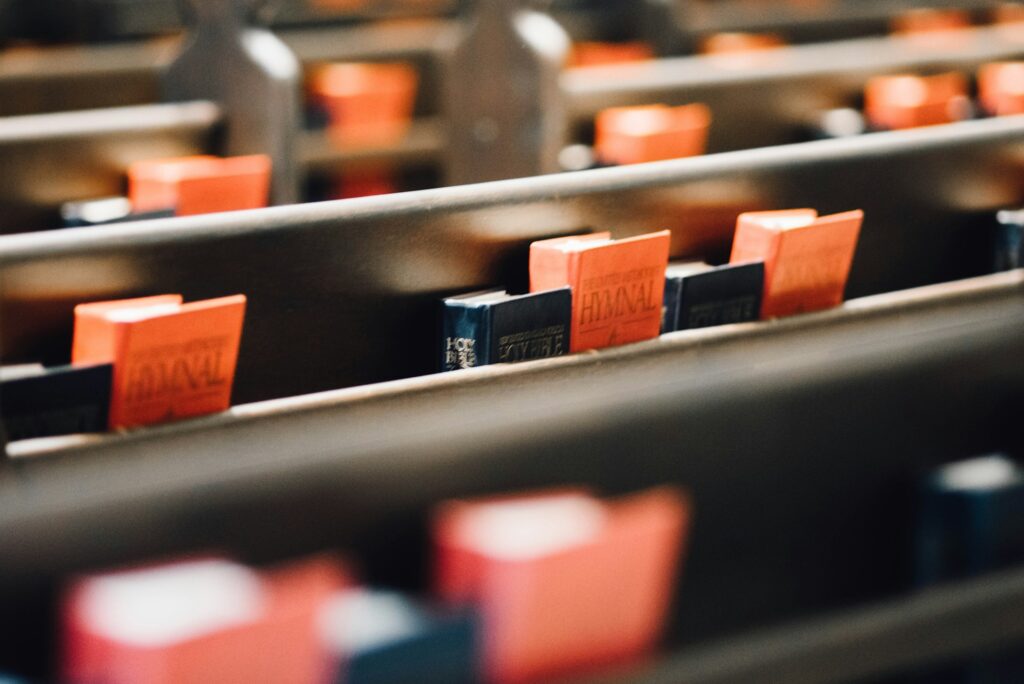Sing a new song to the Lord – literally! Music can move from being new, to familiar, to over-familiar, to stale. We can all think of a piece of music we sing in church that has lost its impact because of overuse. New words and melodies cause us to think about what we are singing, praying and doing in a new way.
Introducing new music is a secondary function of being a cantor, after being a psalmist, and is closely linked to being a song leader.
It does require some extra skills in engaging with your assembly, thinking how best to
New music criteria
Don’t introduce new music just for the sake of it. When choosing new music to use in liturgy, ask yourself whether it is a good fit:-
- musically – technically suitable for the instruments / voices / skills / assembly you have, aesthetically pleasing, of suitable quality for the worship of God?
- liturgically – meets the requirements of the rite it is accompanying? See Celebrating the Mass or the General Instruction of the Roman Missal
- pastorally – relevant to this assembly and this celebration, enables it to express its faith in a way meaingful to it?
If it doesn’t meet all these criteria, consider a different piece of music.
For example, I once heard a Gloria set to the theme tune of the BBC soap EastEnders. Using well-known tunes can be advantageous if used sensitively – Vaughan Williams used English folk melodies for many of his hymns, such as Kingsfold for I heard the voice of Jesus say – but this particular idea clearly fails on at least one of these criteria.
Evaluation cycle
Introducing a new piece of music typically follows a cycle of actions similar to this:
Prepare
Having checked that the music meets the criteria above, learn it! Identify any difficult sections or passages that might prove tricky to your assembly and think about how you might introduce it to them
Explain
It helps people to know why they are doing something new. Associate the music with the readings, prayers of the day, the liturgical season or liturgical purpose
Introduce
Depending upon the piece of music, a “rehearsal” to introduce the music to the assembly may be required. There are several options for this (see below)
Repeat
Use a piece of music for a period of time – maybe a liturgical season – to allow it to bed in. Repetition helps the assembly to learn.
Reflect
If it worked, why? Can you use that knowledge in choosing other pieces of music?
If it failed, don’t give up at the first attempt, but allow it to run for one or two more times before dropping it. If it failed, why? What can you learn for next time?
Rehearsals

First of all, do you actually need to rehearse a new piece of music? If it is responsorial in nature, like a Lamb of God, Penitential Act or Communion chant, simply indicating to the assembly when to repeat what they have heard is often sufficient. If they don’t get it the first time, they probably will the second time.
If introducing a new hymn tune, you may want the organist / keyboard player to play the melody through first (without accompaniment), you sing the first verse or two and invite the assembly to join in at verse three.
If you need to rehearse, don’t think of it as a “rehearsal” with your assembly; Mass isn’t school and treating it at such may reduce the assembly’s willingness to join in. Don’t say “we’re going to learn a new piece of music”, rather explain why we are using a new piece of music (see above). If you need to “teach” new music, make it short, positive, relevant and welcoming.
Rehearse what you are going to say. Beware of using humour, it can backfire.
Be sensitive at what time you chose to introduce new music. Often the best time is before Mass starts but people value their private prayer time and you may be intruding on that.
Choose between an “active” rehearsal and a “passive” rehearsal. In an active rehearsal, you stand up in front of your assembly and “teach” it. In a passive rehearsal, you play or sing the piece to the congregation while they listen. Different pieces lend themselves to different means.
You can teach something by splitting it into chunks and inviting the assembly to repeat after you, with a sing-through afterwards.
Don’t go through a piece more than twice in one rehearsal. If the assembly are making mistakes, move on and do a “reminder” before Mass next week. Never scold, always be positive. Say “thank you” after the rehearsal.
“One song to the tune of another”

Most traditional hymn tunes have a metre, a measure of the number of syllables in each line. This is often printed in hymnbooks and indexed at the back. You can swap the tune to another with the same metre (most of the time) in order to sing a hymn to a tune that the congregation know. This allows words to be used that are particularly relevant to the readings or theme of the day that otherwise might not be used. Make sure that the mood of the tune matches the mood of the music.
For example, the hymn “Thou/God, whose almighty word” has metre 664 6644, meaning that the first line has six syllables, the second line has six, the third has four and so on. The usual tune is called Moscow. You an also sing this tune to the UK national anthem because it has the same metre! When comparing this tune to the three criteria above, it would probably fail on the pastoral measure because of that association. The hymn tune Austria is a very strong tune but has similar connotations as the German national anthem.
If changing the tune, make sure that it also fits the stresses of the music. Try singing “The king of love my shepherd is” (metre 87 87) to the hymn tune Stuttgart. You’ll soon come unstuck. They both have the same metre but the stresses are on different beats of the bar.
Tips
Don’t be too ambitious. Play to the strengths of your assembly – and your musicians – both in terms of the music they like to sing and their range of musical skill.
Do simple things well! If the assembly finds its voice in singing something relatively simple, that is better than attempting something complicated and leaving your congregation foundering.
If you’re doing something new, also do something familiar in the same service as an anchor for people who struggle to join in the new music.
Think about the ways you can prepare people for new music. If you have overheads or projectors in use at your church, make sure the words are available and the operator knows when to change between slides. You might have space in the parish weekly newsletter to print the words of a new song. Song words are typically under copyright – always make sure you have obtained permission or a licence to reproduce them.
If you are using languages other than English, explain what the text means (paraphrase it if necessary). Think about Taize pieces that you sing; if you didn’t know what the Latin meant, could you sing the song as meaningfully?
Give music a rest. Have a cycle of Mass settings you can move through over the course of a year. As a minimum, you might want to have one for Ordinary Time, Advent and Lent, and one for feast days and festival seasons like the period between Christmas time and Lent, and during Easter time.
This is part of a series of posts summarising a workshop given at the Society of St Gregory Summer School 2014. Although this topic is specifically aimed at cantors, it is relevant to musical directors too.
